Synthesis,characterization and application of PVA/ionic liquid mixed matrix membranes for pervaporation dehydration of isopropanol
Ganesh B.Thorat,Smita Gupta,Z.V.P.Murthy*
Department of Chemical Engineering,Sardar Vallabhbhai National Institute of Technology,Surat 395007,Gujarat,India
1.Introduction
Pervaporation is a membrane separation process and it is gaining significant attention in a variety of industries ranging from chemical to pharmaceutical and petrochemical for the separation of organic solvents[1-6].It is the process in which one of the components of a liquid mixture is separated from the feed mixture by selective evaporation through a membrane.Pervaporation follows the mechanism of the solution-diffusion model for the transport of fluid through the membrane which is a three step process:(1)The first step involves sorption at the interface between the feed and the membrane,(2)The second step involves diffusion across the membrane due to concentration gradients(rate determining steps),and(3)The third step is desorption into the vapor phase at the permeate side of the membrane.In older days,liquid-liquid extraction and distillation have been used for the separation of organic solvents and major drawback of liquid-liquid extraction is downstream processing due to the presence of extracting solvent[7].In general,pervaporation is widely used in dehydration of alcohols and other chemicals[8-17].Recently,graphene oxide is also used in the mixed matrix pervaporation membranes along with different other nanomaterials[18-20].Hoofet al.[21]did economic comparison between azeotropic distillation and combination of distillation and pervaporation for dehydration of isopropanol and proved that,from energy point of view,it is better to use pervaporation rather than azeotropic distillation.According to Feng and Huang[22]pervaporation has advantages such as cost effective,energy efficient and simple for operation.There are three major processes widely used for the production of isopropanol or isopropyl alcohol(IPA):(1)vapor phase hydration of propylene,(2)mixed vapor-liquid phase hydration of propylene at low temperature and high pressure,and(3)liquid phase hydration of propylene at high temperature and high pressure.In these hydration processes,IPA forms azeotrope with water at 87.4%concentration[23].IPAis used as cleaning agentin semiconductor,pharmaceutical,and microelectronics industries[24,25].Also,IPAis used as solvent for preparation of cosmetics,oils,waxes,aerosol formulation,etc.[23].
The key success of pervaporation process depends upon:(1)choice of polymeric membrane for a particular application,(2)chemical interaction between polymer and feed component,(3)long term stability of membrane with good mechanical strength,and(4)better permeation flux and membrane selectivity[26].Many researchers have worked on supported ionic liquid membranes(SILMs)for dehydration of alcohols by pervaporation,but the major drawbacks of SILMs are(1)loss of liquid through membrane pores,(2)evaporation ofliquid,and(3)instability of SILMs[27-29].Widely used membranes for pervaporation applications are polymeric and inorganic.Polymeric membranes such as polyvinyl alcohol(PVA)membranes are highly hydrophilic in nature.PVA is the first membrane material used for pervaporation application and most widely used for dehydration of organics[30-34].To make hydrophilic membrane,water is used as solvent for PVA and PVA easily dissolves in water due to the presence of hydrophilic groups[35].Membranes made from only PVA have showed low separation selectivity and permeation flux.Therefore,to overcome this problem,PVA needs some modification to improve its hydrophilicity.There are numerous ways to modify PVA,viz.,(1)blending with polyelectrolyte complex[36],(2)crosslinking[35],(3)surface modification,such as addition of nanoparticles[26],(4)addition of multifunctional additives,and(5)chemical modification using filler materials,such as sodium montmorillonite[37].Of late,ionic liquid incorporated membranes are used in pervaporation[38,39].
To the best of our knowledge,there is no earlier publication of PVA/IL membranes for dehydration of IPA by pervaporation.In the present work,composite membranes were prepared by simple solvent evaporation method to study their pervaporation performance for dehydration of IPA.
2.Experimental
2.1.Materials
The chemicals used for the synthesis of membranes were poly(vinyl alcohol)(PVA,purchased from Qualigens Fine Chemicals,Mumbai,India),hydrophilic ionic liquids 1-n-butyl-3-methylimidazolium chloride(BMIMCl),1-hexyl-3-methylimidazolium chloride(HMIMCl),1-octyl-3-methylimidazolium chloride(OMIMCl),and 1-hexyl-3-methylimidazolium tetrafluoroborate(HMIM BF4).All the ionic liquids were purchased from TOKYO Chemical Industry,Japan.Glutaraldehyde(GA)(SDFCL,Mumbai,India)was used as crosslinking agent.Distilled water(pH 5.9 ± 0.2,conductivity 1.0 μS·cm-1;Millipore,Elix,Bangalore,India)was used as solvent.For pervaporation experiment,isopropanol(FINAR Limited,Ahmedabad,India)was used.
2.2.Fabrication of composite membrane
Firstly,8.0 g of PVA was dissolved in the 100 ml of distilled water and stirred for 3h followed by heating at 95°C so as to get homogenous solution.PVA-water solution was filtered to remove impurities present in PVA.After that,homogenous solution was kept in freezer for 24 h to remove airbubbles.Different amounts of ionic liquids(BMIMCl)such as 0,0.25,0.5 or 0.75 g was added into solution under stirring for 2 h to study the effect of ionic liquid on pervaporation performance.Small amount of glutaraldehyde was added to ensure the strong linkage of IL with PVA at high pressure.Fig.1 shows the interaction between PVA/BMIMCl composite membranes[40].
The homogenous PVA/BMIMCl solutions were kept in vacuum oven to remove air bubbles.The fabrication of PVA/BMIMCl composite membrane is done by casting the same on petri-dish and kept at atmospheric temperature and pressure to evaporate water for 3 days.Dried membranes were removed and washed with ethanol,and dried under vacuum at 40°C for 1 day to obtain PVA/IL composite membrane.Based on ionic liquid concentration,prepared membranes were named as M-0(IL=0 g),M-0.25(IL=0.25 g),M-0.5(IL=0.50 g)and M-0.75(IL=0.75 g),respectively.
2.3.Membrane characterization
2.3.1.Contact angle measurement
To study the hydrophilicity of pure PVA membrane and PVA/IL composite membranes,the water contact angle was measured by 15 EC video based optical contact angle(OCA)measuring instrument by Dataphysics GmbH,Germany.Deionized water droplets were led onto the top surface of membrane by syringe at room temperature.Rightside and left-side contact angles were measured using sessile drop method and average of both was taken as final contact angle.
2.3.2.Fourier transform infrared spectroscopy(FTIR)
FTIR spectra of all the membranes were obtained by FTIR-8400S(SHIMADZU)with DRS system.All the membranes were hydraulically pressurized at 350 kg·cm-2with KBr pellet and spectra were recorded in the range of 4000-500 cm-1.
2.3.3.Scanning electron microscopy(SEM)
Scanning electron microscopy(Hitachi,3400 N,Japan)was used for the analysis of membranes morphology.Before the analysis,all the membranes were gold coated to avoid charging by an ion sputter film deposition(Hitachi,E-1010,Japan).
2.4.Pervaporation experiments
The pervaporation experiments of composite membranes were carried out on pilot scale membrane system(Permionics Membranes,Vadodara,India)as shown in Fig.2.In all the experiments,permeate side pressure was maintained at1066 Pa.The feed mixture was circulated by circulation pump(Syp Engineering Company,Sholapur,India).The membrane module is circular in shape and having porous metal sheet made from stainless steel.On the top surface of porous metal sheet,membrane was kept and permeate was collected from downside of membrane module.The effective surface area of the membrane is 27.34 cm2and the capacity of feed tank is 4000 cm3.Hot water was circulated through the jacket by constant temperature bath(Julabo Laboratory GmbH,Germany)so asto vaporize feed mixture.The partially vaporized feed mixture was pumped and passed through superior side of the membrane.The permeate valve was closed and feed mixture was circulated for 1 h throughout the set-up so as to establish equilibrium.After achieving equilibrium,permeate valve was opened and vacuum was applied on downstream side of the membrane.The vacuum was kept constant at1066 Pa by vacuum pump(ILMVAC GmbH,Germany).Due to partial pressure difference on both side of membrane,permeate was passed through membrane.Permeated vapors were collected and condensed by cold traps inserted into the cold water.The concentrations in feed and permeate were measured by gas chromatography using thermal conductivity detector.The applied chromatography was Perkin Elmer,USA(packed column-2 Mtrs.X 1/8″OD SS Column P/w Porapak-Q,80/100 Mesh Size,chromatopack).
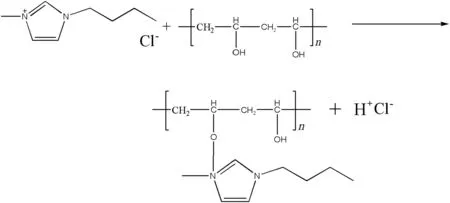
Fig.1.Interaction between PVA and BMIMCl.
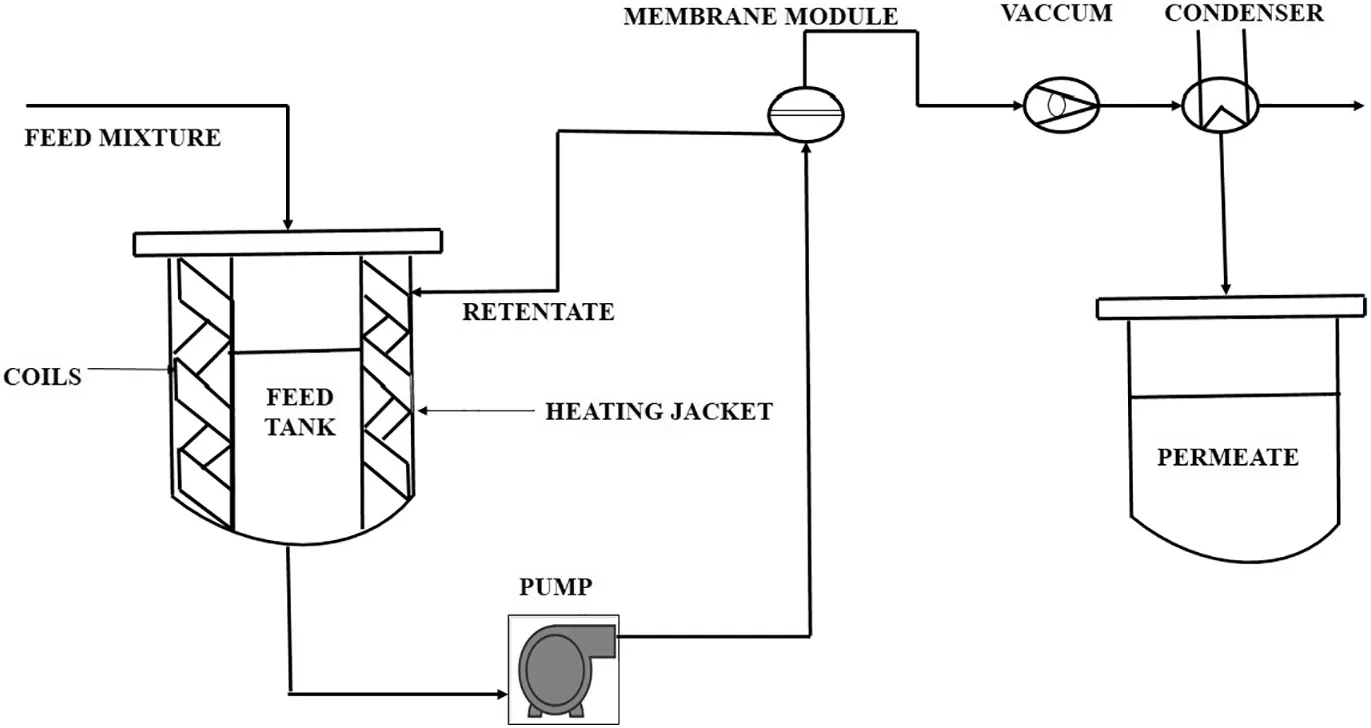
Fig.2.Schematic representation of a pervaporation set-up.
Pervaporation data was obtained by varying feed composition and feed temperature for M-0,M-0.25,M-0.5 and M-0.75.Various parameters such as total flux(J)and selectivity(α)were calculated.Total flux was calculated by weighing condensed permeate within particular interval.Selectivity was estimated by calculating feed side and permeate side concentrations.Total flux is given by the following equation:

where,Qis the mass of permeate,Ais the effective membrane area andtis time.
Selectivity(α)is given by the following equation:

where,yandxare the mass fractions of components A and B in permeate and feed,respectively[25].
The following equation is used to calculate diffusion coefficient:

where,Jiis the flux for speciei,Diis the diffusion coefficient for speciei,Ciis the concentration of speciei,and δ is the thickness of membrane.


Fig.3.Contact angle of membranes M-0,M-0.25,M-0.5 and M0.75 at room temperature.
The enrichment factor for componentiis given by the following relation:where,Wipis the mass fraction of componentiin the permeate andWifis the mass fraction of componentiin the feed[41].
2.5.Degree of swelling of membrane
Small pieces of membranes were taken and dried under vacuum for 4 h and weighed by digital microbalance.Dried membranes were immersed in IPA/water solutions at different compositions.After 24 h all the membranes were taken out from solutionsand wiped with tissue paper 2 to 3 times.The swollen membranes were weighted as quickly as possible by digital microbalance.Each experiment was performed 2 times and results were averaged.The degree of swelling(DS)was calculated by the following formula[25]:

where,WsandWdare the mass of the swollen and dry membranes,respectively.
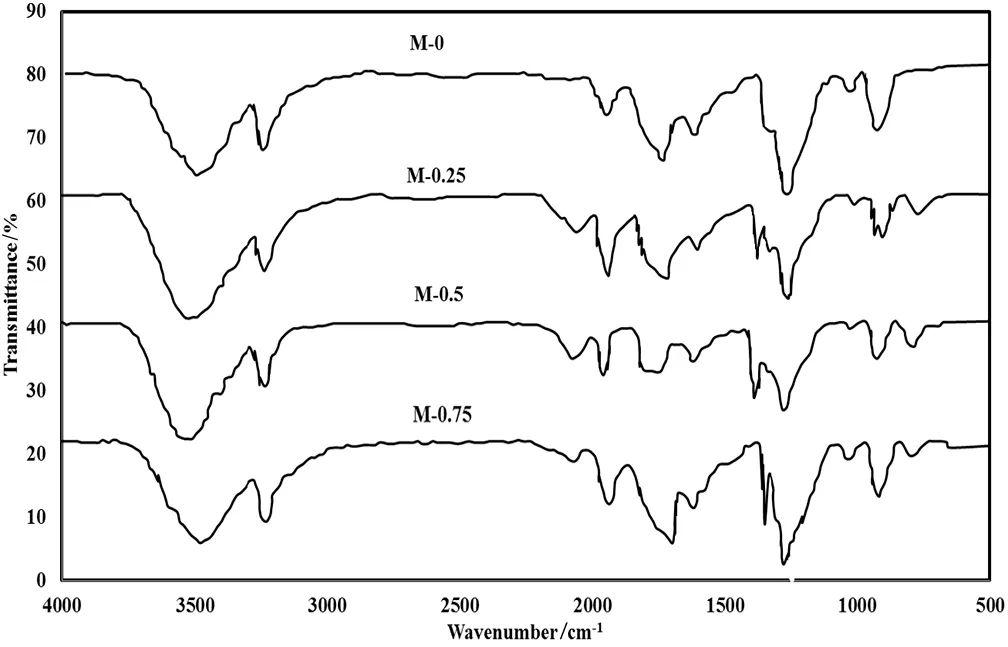
Fig.4.FTIR spectra of M-0,M-0.25,M-0.5 and M-0.75.
3.Results and Discussion
3.1.Membrane characterization
3.1.1.Contact angle measurement
Usually water contact angle is used to study the hydrophilicity and hydrophobicity of membranes.In general,the smaller the water contact angle,the higher is the hydrophilicity of membrane[42].Fig.3 showed the water contact angle of PVA/BMIMCl composite membranes containing different amount of IL and it could be seen that water contact angle decreases with increase in IL content,implying that PVA/BMIMCl membranes were hydrophilic in nature.The water contact angle for plain PVA membrane(M-0)was observed as 56.45°and was decreased from 48.15°to 37.4°with increase in IL content from 0.25%to 0.75%.This shows that on increasing the IL concentration hydrophilicity is increased.
3.1.2.FTIR studies
FTIR spectra of pure PVA membrane and PVA/BMIMCl membranes were shown in Fig.4.A characteristic strong band was observed at wavelength 3500 cm-1in all the membranes which corresponds to O¯¯H bond stretching.Significant difference was not observed in the transmittance of O¯¯H bond due to the addition of BMIMCl into PVA matrix.Broad peak was observed in between 1600 and 2000 cm-1which represents C¯¯C stretching.The peak around 3250 cm-1wavelength represented C¯¯H stretching and scissoring.The transmittance in the region 1300 to 1500 cm-1was due to C¯¯N presence in ionic liquid.The Cl-functional group was observed in the range 750 to 1000 cm-1.
3.1.3.Scanning electron microscopy(SEM)
Fig.5 showed surface morphology of pure PVA and PVA/BMIMCl membranes.Pure PVA membrane showed homogenous,compact and uniform structure.On increasing the concentration of ionic liquid in the membrane matrix,the surface roughness increased.From Fig.5,no significant difference of SEM surface image between M-0 and M-0.25 was observed because of the addition of insignificant amount of ionic liquid.The membrane M-0.75 showed more surface roughness than M-0.5 due to more amount of ionic liquid.No superficial impurities and voids were observed on the surface of all the membranes,after increasing the concentration of ionic liquid.
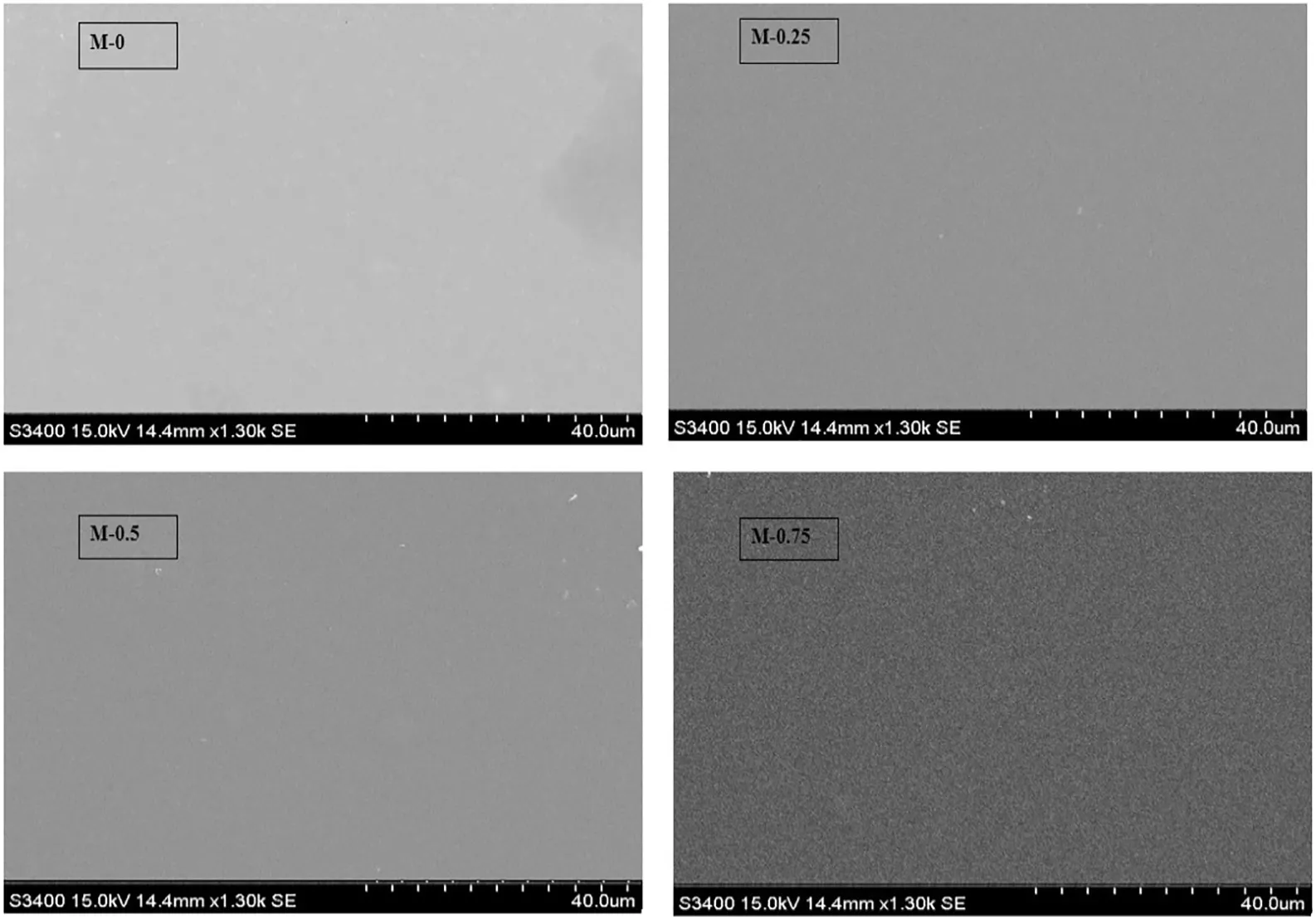
Fig.5.SEM surface micrographs of pure PVA and PVA/BMIMCl composite membranes.
3.2.Degree of swelling
Degree of swelling depends upon structure of membrane and mutual interaction between polymer and permeate[43].The effect of feed water concentration with different concentration of IL in membrane,on degree of swelling was illustrated in Fig.6.It was observed that degree of swelling increased with increase in feed water concentration.This might have happened because of increased hydrophilicity of membrane,due to which the interaction between water molecules and membrane matrix was increased.It was also observed from Fig.6 that the increase in the amount of ionic liquid(BMIMCl)in PVA would lead to more hydrophilic membrane which subsequently increased degree of swelling.
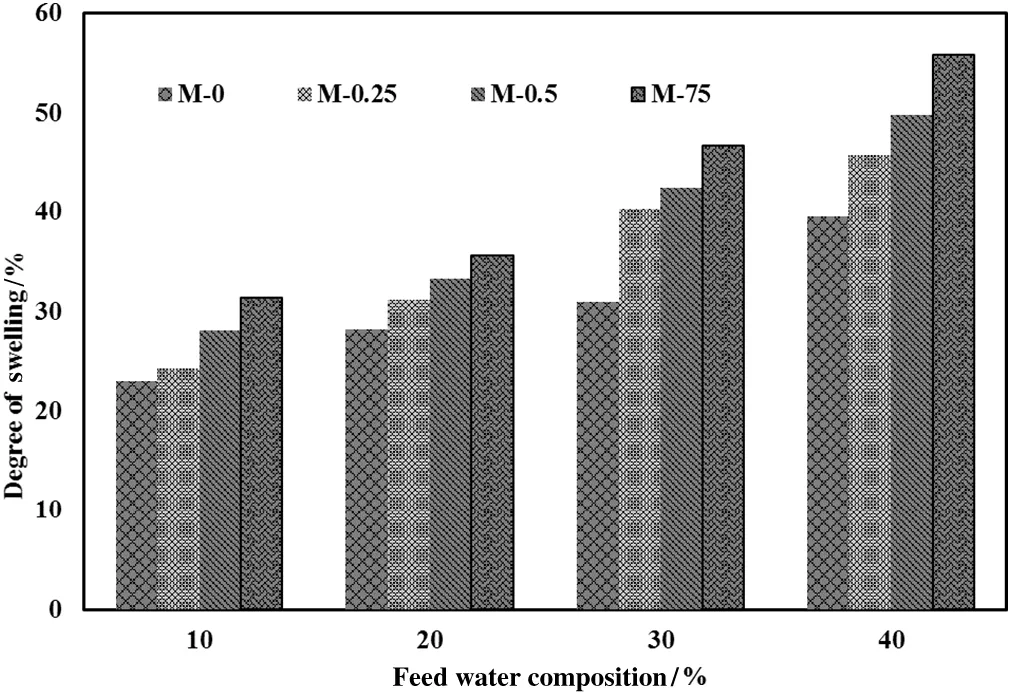
Fig.6.Effect of feed water concentration on degree of swelling for M-0,M-0.25,M-0.5,M-0.75 at room temperature.
3.3.Effect of feed composition
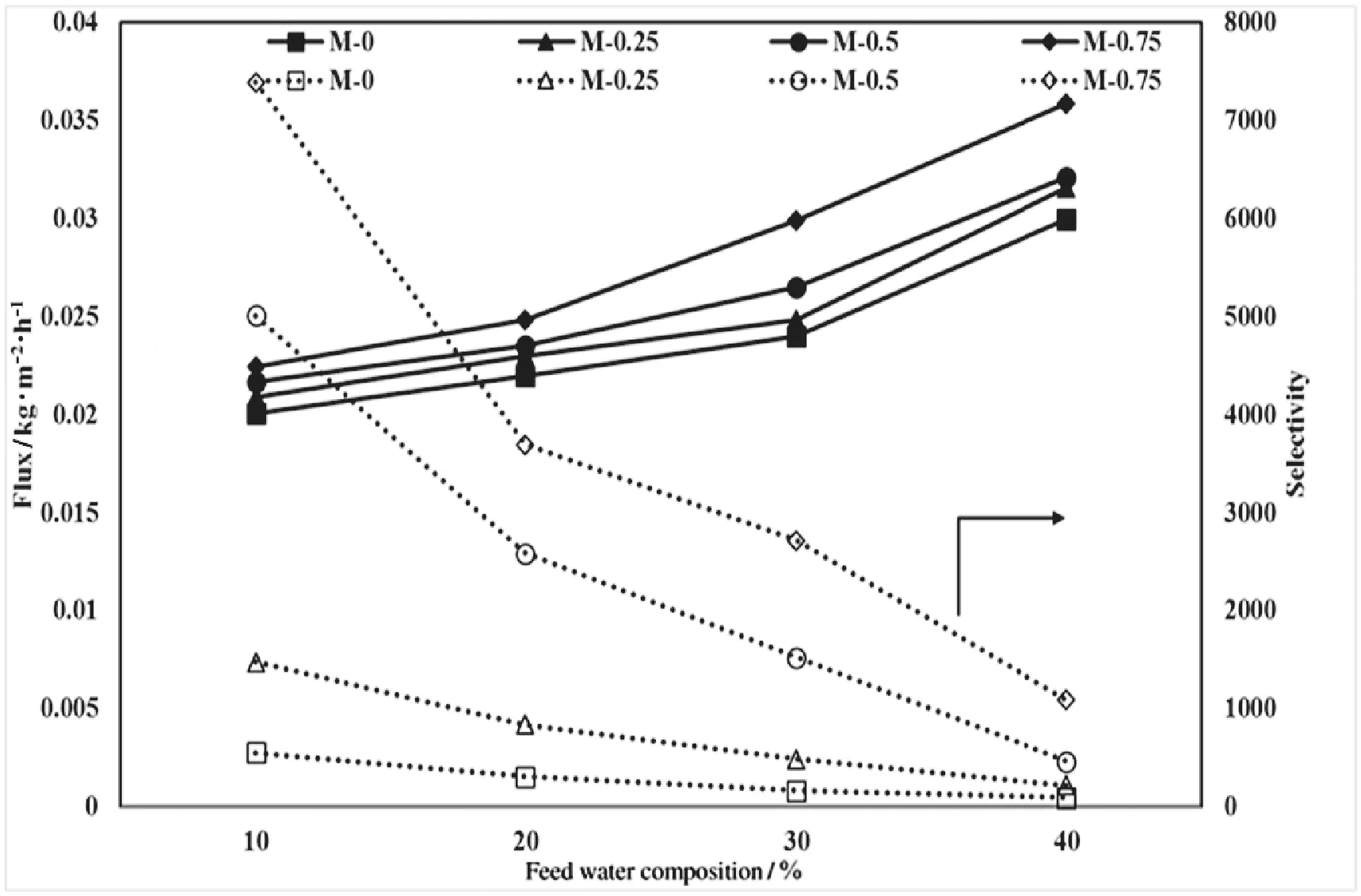
Fig.7.Effect of feed water composition on flux and selectivity for M-0,M-0.25,M-0.5 and M-0.75at 50°C.
Pervaporation of IPA-water has been studied using pure PVA and PVA/BMIMCl membranes.The feed composition was varied from 10%water to 40%water.Effect of feed composition on permeation flux and selectivity was presented in Fig.7.It was found that permeate flux increased for all PVA and PVA/BMIMCl membranes with increasing content of feed water,but at the same time selectivity was decreased.The same behavior was observed in literature[24,35].The increase in permeation flux was due to hydrophilic nature of ionic liquid.This was due to the presence of hydrophilic functional groups such as-OH and-CN which allowed only water molecules to pass through the membrane rather than IPA.Forall the membranes,it was observed that selectivity exponentially decreased at higher water concentration.The reason for this behavior was that as the water concentration increased in feed,polymeric chain became more flexible and some IPA molecules might pass through the membrane which resulted in the increased flux and decreased selectivity[35,42].
In order to study the extent of pervaporation,the total flux and fluxes of water and IPA as a function of ionic liquid content in the membrane for 10%water in the feed were plotted in Fig.8.From Fig.8,it can be observed that the values for total flux and flux of water were coinciding with each other,which reduces flux of IPA.Fig.9 displayed the effect of ionic liquid content in membrane on flux and selectivity for 10%water in feed.It was observed that with the increase in ionic liquid content in the membrane matrix,both selectivity and flux increased.
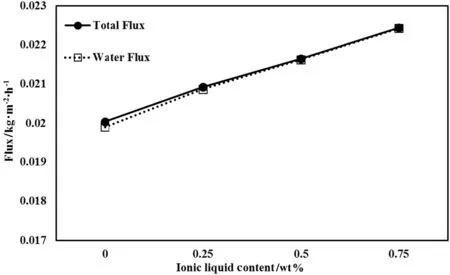
Fig.8.Variation of total flux and fluxes of water and IPA with different mass content of ionic liquid for 10%feed water concentration.
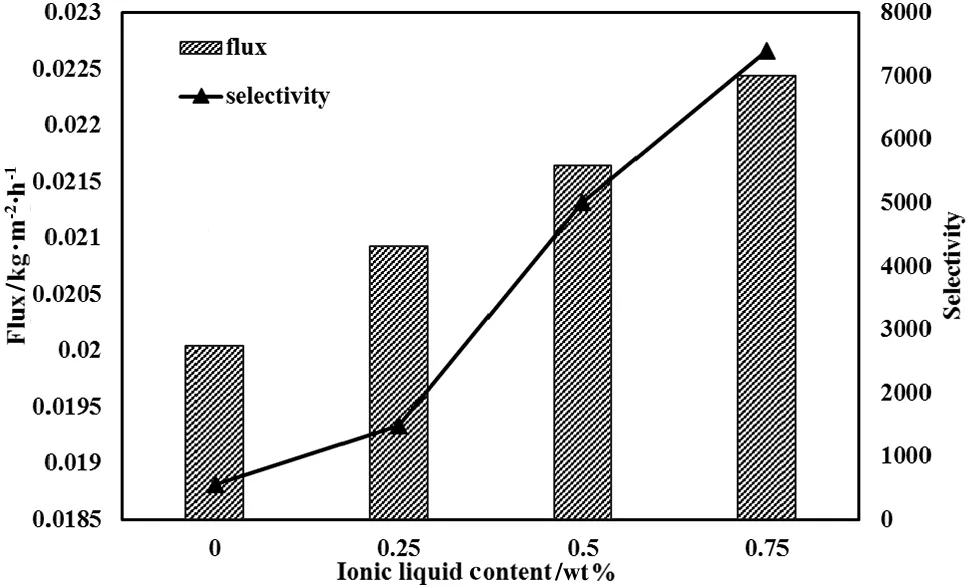
Fig.9.Variation of total flux and selectivity with different mass%of ionic liquid for 10%feed water concentration.
Table 1 shows the comparison of the pervaporation performance between the obtained PVA/BMIMCl composite membrane and other membranes reported in the literature.On comparing these literature results,it can be said that the efforts done in the present series of experiments for the modification of PVA membrane by incorporating BMIMCl in the membrane matrix shows significant improvement in permeate flux as well as in selectivity.

Table 1A comparison of pervaporation performance of the different membranes made from polymers for dehydration of isopropanol
3.4.Effect of feed temperature
To determine the effect of temperature on all the membranes in terms of total flux and selectivity,series of experiments were performed at different temperatures,varied from 50 °C to 80 °C for 10%aqueous solution(Fig.10).From Fig.10,it was observed that increase in the temperature lead to increase in total flux.As the temperature was increased,vapor pressure of water increased and also polymer chain got expanded which generated free volume in polymer matrix and ultimately it resulted into increased total flux[32].But selectivity of all the membranes was decreased with increase in temperature.This might be due to permeation of IPA molecules with water through the expanded membrane at higher temperature.
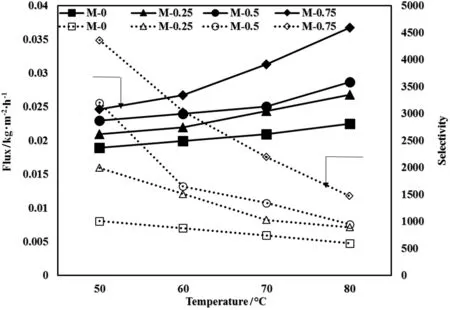
Fig.10.Effect of feed temperature on total flux and selectivity for M-0,M-0.25,M-0.5 and M-0.75 for 10%feed water.
Temperature dependency of pervaporation experiments can be expressed in terms of activation energy by the following Arrhenius relation[22]:

where,J0is the pre-exponential factor(kg·m-2·h-1),Ejis the activation energy(kJ·mol-1),Tis temperature(K)andRis the gas constant.Arrhenius plot of lnJ versus1/Twas illustrated in Fig.11 and it is observed that all plots are linear.The values of activation energy of permeate were calculated from slopes of lines and are given in Table 2.From Table 2,it can be interpreted that increase in BMIMCl content in membrane matrix resulted in the reduction of activation energy,which meant that lower energy would be required for membranes M-0.25,M-0.5 and M-0.75 as compared to M-0 to get permeate through membrane[44].
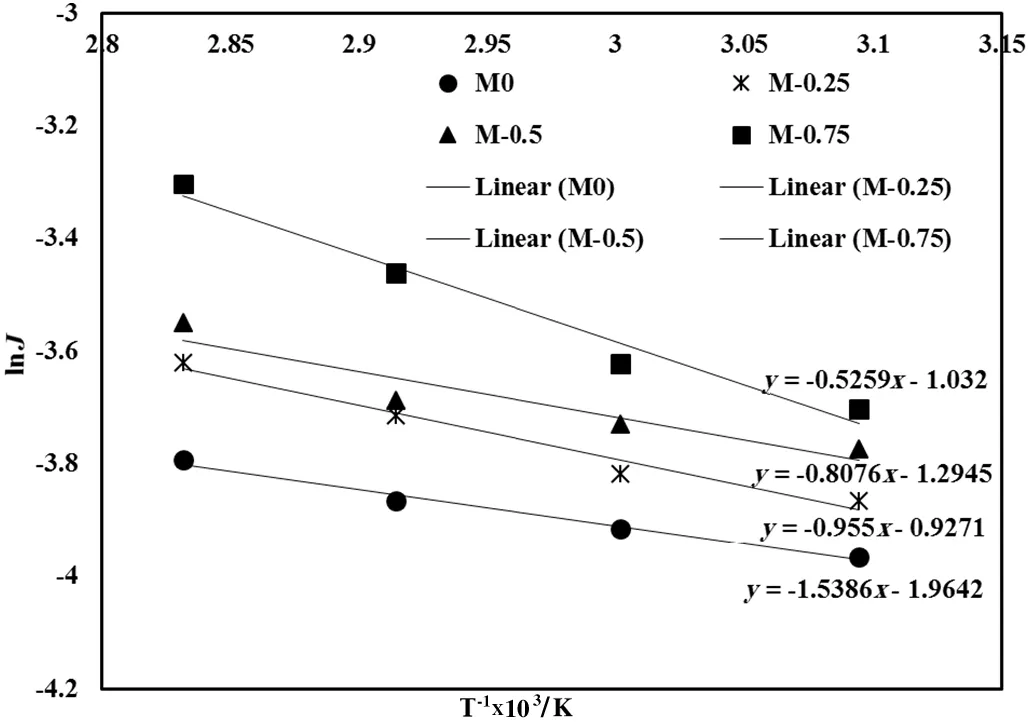
Fig.11.Arrhenius plot of ln J versus 1000/T for 10%of water in feed.

Table 2Arrhenius activation energy for permeation

Table 3Diffusion coefficients for water and isopropanol for different feed water concentration at temperature 50°C

Table 4Diffusion coefficients for water and IPA at different temperatures for 10%water
3.5.Effect on diffusion coefficients
In pervaporation process,separation of mixture takes place by solution-diffusion mechanism,which follows three steps:sorption,diffusion and desorption.In these three steps,diffusion controls the passage of permeate[45].Therefore,it is important to calculate the diffusion coefficient of water and isopropanol to get some information regarding the transport mechanism of water through membrane.The diffusion coefficients(calculated from Eq.(3))at different feed concentrations and temperatures are presented in Tables 3 and 4.It can be observed from Tables 3 and 4 that for each membrane,the diffusion coefficients of both water and IPA were increasing with the increase in feed water concentration,temperature and IL concentration[46].Diffusion coefficient for water was quite high as compared to IPA which concluded that composite membranes are having more selectivity towards water at higher concentration of water in feed.For 10%feed water,diffusion coefficient for water has increased from 1.350 × 10-9m2·s-1to 1.436 × 10-9m2·s-1.With the increase in temperature,diffusivity increases but subsequently solubility decreases[47].Obviously,PVA/BMIMCl membranes consumed less energy in comparison with plain PVA membrane because of increased hydrophilicity.
3.6.Effect on enrichment factor(β)
Variation of enrichment factor(calculated from Eq.(4))with feed water concentration is illustrated in Fig.12.It was observed that with increase in feed water concentration for a particular membrane,enrichment factor decreases.But,incorporation of ionic liquid in PVA matrix increased the enrichment factor because of enhancement of hydrophilic nature of membranes.Approximately similar trend of increasing enrichment factor was observed for all the membranes with the decrease in feed water concentration and the increase in IL concentration in PVA membranes.The enrichment factor of water was increased from 5 to 20 for 10%water in feed.This happened due to BMIMCl which allows only water molecules to pass through the membrane.As discussed in previous section, flux was increased with increase in the amount of ionic liquid in membrane matrix.Similar behavior was obtained by Izaket al.[41]for the separation of butan-1-ol and water.

Fig.12.Variation of enrichment factor with feed water concentration for M-0,M-0.25,M-0.5 and M-0.75 at 50°C.
3.7.Effect of alkyl chain of ionic liquid on pervaporation
3.7.1.Effect of feed composition
To study the combined effect of feed composition and alkyl chain of ionic liquids on pervaporation,we used two more ionic liquids namely 1-hexyl-3-methylimidazolium chloride(HMIMCl)and 1-octyl-3-methylimidazolium chloride(OMIMCl)which were having the same anionic group.The effect of BMIMCl on pervaporation of IPA-water mixture was discussed in previous section.Fig.13 illustrates the effect of feed composition and length of alkyl chain of ionic liquid at 50°C.Though,it was observed that there was a trend of increasing permeate flux with increase in feed water concentration for all the three membranes but a decrease in permeate flux with the increase in the length of alkyl chain of IL was also observed.There is a linear relationship between alkyl chain of ionic liquid and vaporization enthalpy[48].Permeation flux of PVA/BMIMCl membrane was higher than PVA/HMIMCl and PVA/OMIMCl.Permeate flux follows order asJPVA/BMIMCl>JPVA/HMIMCl>JPVA/OMIMCl.The permeate flux declined for PVA/HMIMCl and OMIMCl membranes due to dense structure ofmembranes.Huddleston reported[49]that increase in the alkyl chain of ionic liquid increased viscosity and decreased hydrophilicity.However,the effect of increasing length of alkyl chain on selectivity was somewhat different.Similarly,from Fig.13,decreasing trend of selectivity with increasing feed water concentration for each membrane was observed,but simultaneously an increase in selectivity with the increase in the alkyl chain length of IL was also observed.Selectivity followed the order as αPVA/OMIMCl> αPVA/HMIMCl> αPVA/BMIMCl.For 10%feed water at 50 °C,selectivity increased from 7389 to 10,053.This might be due to the reason of increase in the van der Waals and Coulombic interaction with the increase in the length of alkyl chain of the IL which increased viscosity and density of ionic liquid[50].
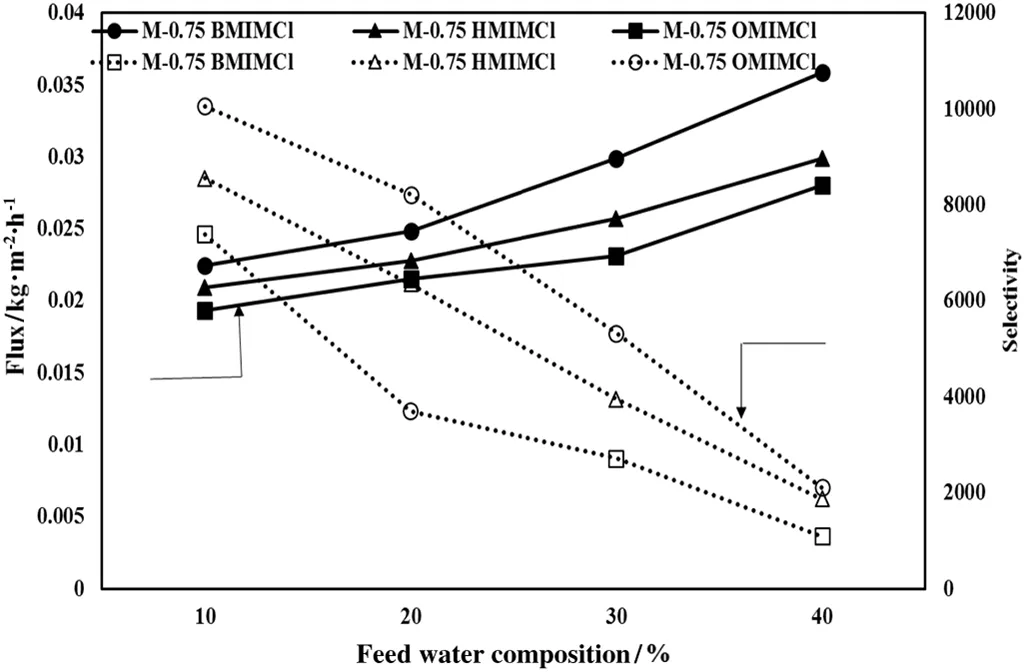
Fig.13.Effect of feed water composition on total flux and selectivity for M-0.75 BMIMCl,M-0.75 HMIMCl and M-0.75 OMIMCl at 50°C.
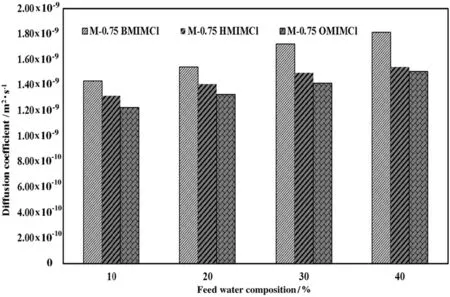
Fig.14.Effect of feed water composition on diffusion coefficient for M-0.75 BMIMCl,M-0.75 HMIMCl and M-0.75 OMIMCl at 50°C.
3.7.2.Comparison of diffusion coefficients

Fig.15.Effect of feed water composition on total flux and selectivity for M-0.75 HMIMCl and M-0.75 HMIMBF4 at 50°C.
The diffusion coefficients ofM-0.75 BMIMCl,M-0.75 HMIMCland M-0.75 OMIMCl membranes are illustrated in Fig.14.It was observed that diffusion coefficients of both water and isopropanol were increased for M-0.75 BMIMCl,M-0.75 HMIMCl and M-0.75 OMIMCl at all feed compositions.This is because of hydrophilic property of ionic liquid which increases free-volume of membrane and decreases compactness and rigidity of membrane matrix.But on the contrary,as we increase the concentration of water in feed for all the three membranes,diffusion coefficient of water has not increased.Considering all this,magnitude of diffusion coefficient for isopropanol is low in comparison with water which concludes that hybrid membranes have greater affinity towards water at higher concentration of feed water.The diffusion coefficients follow the order asDPVA/BMIMCl>DPVA/HMIMCl>DPVA/OMIMClwhich depends on the physical properties of ILs,like viscosity and density.
3.8.Effect of anion of ionic liquid on pervaporation
To study the effect of anion of ionic liquid,we used 1-hexyl-3-methylimidazolium tetra fluoroborate(HMIMBF4)ionic liquid.The effect of feed composition on flux and selectivity for M-0.75 HMIMCl and M-0.75 HMIM BF4at 50°C is represented in Fig.15.Considering the effect of different anions having the same cation(i.e.,HMIM),it was observed that ionic liquid containing Cl-as anion was showing higher flux as compared with the ionic liquid containinganion.This is because of greater hydrophilicity of Cl-anion containing IL as compared withwhich is shown in Fig.16 in terms of contact angle[28].Hence,permeate flux followed the order asJPVA/HMIMCl>JPVA/HMIMBF4and selectivity as αPVA/HMIMBF4> αPVA/HMIMCl.The effect of diffusion coefficient of M-0.75 HMIMCl and M-0.75 HMIMBF4membranes was depicted in Fig.17.It was found that the diffusion coefficient increased with increase in feed water concentration.

Fig.17.Effect of feed water composition on diffusion coefficient for M-0.75 HMIMCl and M-0.75 HMIM BF4 at 50°C.
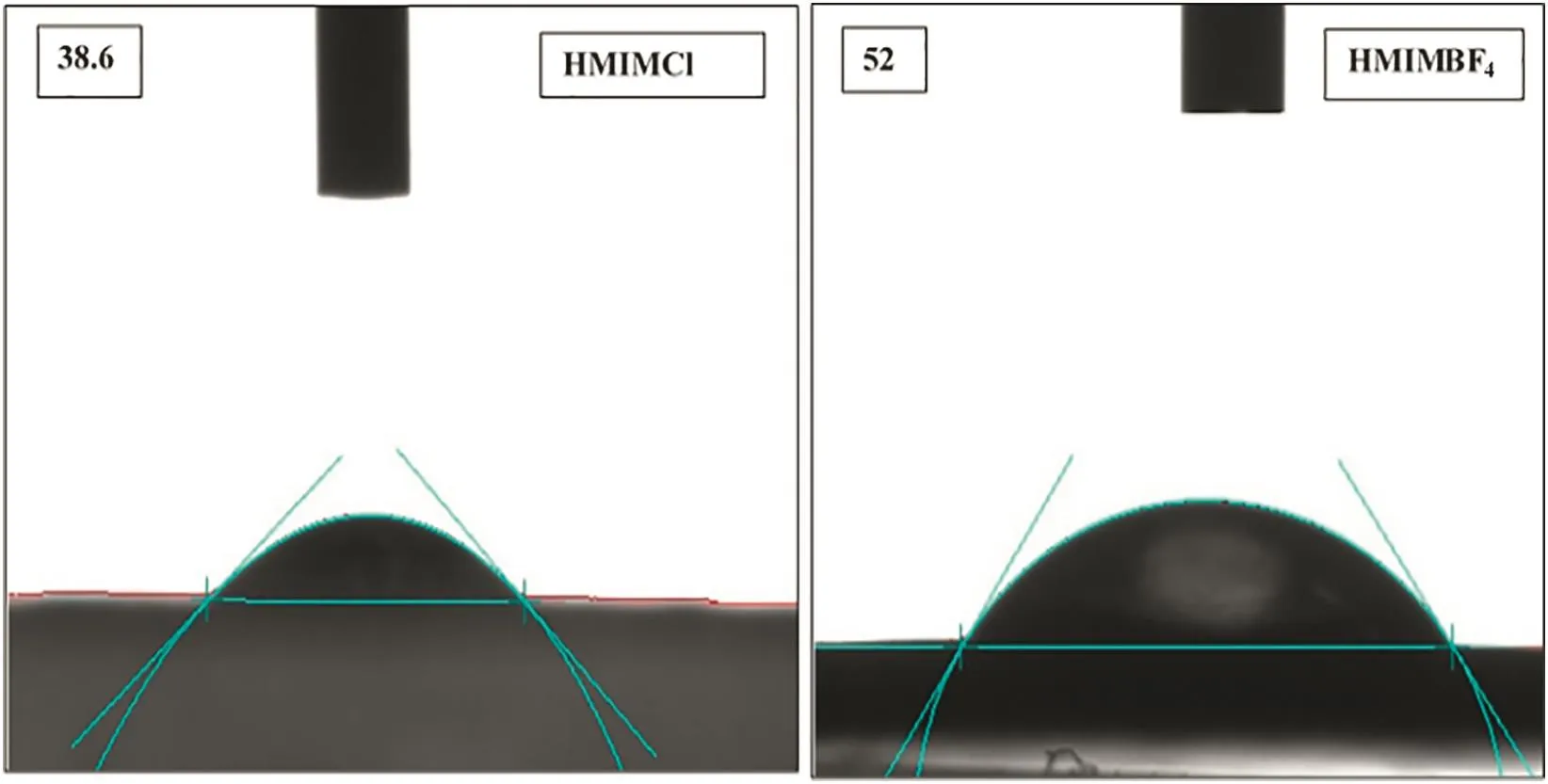
Fig.16.Contact angle of membranes M-0.75 HMIMCl and M-0.75 HMIMBF4 at room temperature.
4.Conclusions
PVA/ionic liquid membranes were fabricated by simple copolymerization method.Effects of feed conditions and feed temperature on pervaporation performance were studied.The composite membranes with ionic liquids exhibited good performance in comparison with plain PVA membrane.This was explained on the basis of increased hydrophilic characteristic of membranes and increased hydrophilicity was proved by water contact angle.It can be concluded that on increasing the length of alkyl chain of ILs flux is decreasing.From the results it was observed that both anions and cations of ionic liquid were showing significant effect on separation performance.Considering the effect of cations,it was observed that the higher alkyl groups of cation were responsible for high selectivity towards water,whereas lower alkyl group was responsible for high flux.This was due to physical properties of ionic liquid(hydrophilicity,viscosity,etc.).Considering the effect of different anions having the same cations,it was observed that Clanion was responsible for high flux,whereaswas responsible for higher selectivity.Length of alkyl chain of imidazolium cation of ILs was significantly responsible for selectivity towards water,whereas Cl-anion of ILs was more responsible for higher flux as compared to
Acknowledgments
The authors acknowledge Sophisticated Analytical Instrument Facility(SAIF),IIT Bombay(India)for characterization analysis of membranes.
[1]D.Shah,D.Bhattacharyya,A.Ghorpade,W.Mangum,Pervaporation of pharmaceutical waste streams and synthetic mixtures using water selective membranes,Environ.Prog.18(1999)21-29.
[2]N.Wynn,Pervaporation comes of age,Chem.Eng.Prog.97(2001)66-72.
[3]Q.Wang,N.Li,B.Bolto,M.Hoang,Z.Xie,Desalination by pervaporation,Desalination387(2016)46-60.
[4]Y.K.Ong,G.M.Shi,N.L.Le,Y.P.Tang,J.Zuo,S.P.Nunes,T.S.Chung,Recent membrane development for pervaporation processes,Prog.Polym.Sci.57(2016)1-31.
[5]Z.Jia,G.Wu,Metal-organic frameworks based mixed matrix membranes for pervaporation,Microporous Mesoporous Mater.235(2016)151-159.
[6]M.J.Salar-García,V.M.Ortiz-Martínez,F.J.Hernández-Fernández,A.P.de los Ríos,J.Quesada-Medina,Ionic liquid technology to recover volatile organic compounds(VOCs),J.Hazard.Mater.321(2017)484-499.
[7]Z.L.Xiu,A.P.Zeng,Present state and perspective of downstream processing of biologically produced 1,3-propanediol and 2,3-butanediol,Appl.Microbiol.Biotechnol.78(2008)917-926.
[8]T.Uragami,T.Saito,T.Miyata,Pervaporative dehydration characteristics ofan ethanol/water azeotrope through various chitosan membranes,Carbohydr.Polym.120(2015)1-6.
[9]Y.T.Ong,S.H.Tan,Pervaporation separation of a ternary azeotrope containing ethyl acetate,ethanol and water using a buckypaper supported ionic liquid membrane,Chem.Eng.Res.Des.109(2016)116-126.
[10]H.S.Samanta,S.K.Ray,Separation of ethanol from water by pervaporation using mixed matrix copolymer membranes,Sep.Purif.Technol.146(2015)176-186.
[11]N.Jullok,R.Van Hooghten,P.Luis,A.Volodin,C.Van Haesendonck,J.Vermant,B.Van der Bruggen,Effect of silica nanoparticles in mixed matrix membranes for pervaporation dehydration of acetic acid aqueous solution:Plant-inspired dewatering systems,J.Clean.Prod.112(2016)4879-4889.
[12]H.Sardarabadi,S.M.Mousavi,E.Saljoughi,Removal of 2-propanol from water by pervaporation using poly(vinylidene fluoride)membrane filled with carbon black,Appl.Surf.Sci.368(2016)277-287.
[13]K.Y.Jee,N.Kim,Y.T.Lee,The effect of metal complex on pervaporation performance of composite membrane for separation ofn-butanol/water mixture,J.Ind.Eng.Chem.44(2016)155-163.
[14]W.Zhang,Y.Ying,J.Ma,X.Guo,H.Huang,D.Liu,C.Zhong,Mixed matrix membranes incorporated with polydopamine-coated metal-organic framework for dehydration of ethylene glycol by pervaporation,J.Membr.Sci.527(2017)8-17.
[15]M.Chen,X.Wu,F.Soyekwo,Q.Zhang,R.Lv,A.Zhu,Q.Liu,Toward improved hydrophilicity of polymers of intrinsic microporosity for pervaporation dehydration of ethylene glycol,Sep.Purif.Technol.174(2017)166-173.
[16]H.Wu,T.Zhou,X.Li,C.Zhao,Z.Jiang,Enhancing the separation performance by introducing bioadhesive bonding layer in composite pervaporation membranes for ethanol dehydration,Chin.J.Chem.Eng.23(2015)372-378.
[17]H.R.Mehta,Z.V.P.Murthy,Preparation of sodium montmorillonite clay loaded poly(vinyl alcohol)-chitosan composite mixed matrix membranes and their application in pervaporation dehydration of isopropanol,J.Polym.Mater.33(2016)319-331.
[18]X.Chen,G.Liu,H.Zhang,Y.Fan,Fabrication of graphene oxide composite membranes and their application for pervaporation dehydration of butanol,Chin.J.Chem.Eng.23(2015)1102-1109.
[19]J.H.Jhaveri,Z.V.P.Murthy,A comprehensive review on anti-fouling nanocomposite membranes for pressure driven membrane separation processes,Desalination379(2016)137-154.
[20]J.H.Jhaveri,Z.V.P.Murthy,Nanocomposite membranes,Desalin.Water Treat.57(2016)26803-26819.
[21]V.Van Hoof,L.Van den Abeele,A.Buekenhoudt,C.Dotremont,R.Leysen,Economic comparison between azeotropic distillation and different hybrid systems combining distillation with pervaporation for the dehydration of isopropanol,Sep.Purif.Technol.37(2004)33-49.
[22]X.Feng,R.Y.Huang,Liquid separation by membrane pervaporation:A review,Ind.Eng.Chem.Res.36(1997)1048-1066.
[23]J.E.Logsdon,R.A.Loke,Isopropyl Alcohol,Kirk-Othmer Encyclopedia of Chemical Technology,2000.
[24]J.G.Varghese,A.A.Kittur,P.S.Rachipudi,M.Y.Kariduraganavar,Synthesis,characterization and pervaporation performance of chitosan-g-polyaniline membranes for the dehydration of isopropanol,J.Membr.Sci.364(2010)111-121.
[25]S.Razavi,A.Sabetghadam,T.Mohammadi,Dehydration of isopropanol by PVAAPTEOS/TEOS nanocomposite membranes,Chem.Eng.Res.Des.89(2011)148-155.
[26]M.Sairam,M.B.Patil,R.S.Veerapur,S.A.Patil,T.M.Aminabhavi,Novel dense poly(vinyl alcohol)-TiO2mixed matrix membranes for pervaporation separation of water-isopropanol mixtures at 30°C,J.Membr.Sci.281(2006)95-102.
[27]Y.Qin,J.Sheth,K.Sirkar,Supported liquid membrane-based pervaporation for VOC removal from water,Ind.Eng.Chem.Res.41(2002)3413-3428.
[28]M.Matsumura,H.Kataoka,Separation of dilute aqueous butanol and acetone solutions by pervaporation through liquid membranes,Biotechnol.Bioeng.30(1987)887-895.
[29]Y.T.Ong,K.F.Yee,Y.K.Cheng,S.H.Tan,A review on the use and stability of supported liquid membranes in the pervaporation process,Sep.Purif.Rev.43(2014)62-88.
[30]M.Amirilargani,B.Sadatnia,Poly(vinyl alcohol)/zeolitic imidazolate frameworks(ZIF-8)mixed matrix membranes for pervaporation dehydration of isopropanol,J.Membr.Sci.469(2014)1-10.
[31]D.Hua,Y.K.Ong,P.Wang,T.S.Chung,Thin- film composite tri-bore hollow fiber(TFC TbHF)membranes for isopropanol dehydration by pervaporation,J.Membr.Sci.471(2014)155-167.
[32]Z.V.P.Murthy,M.K.Shah,Separation of isopropyl alcohol-toluene mixtures by pervaporation using poly(vinyl alcohol)membrane,Arab.J.Chem.10(Supplement 1)(2017)S56-S61.
[33]L.L.Xia,C.L.Li,Y.Wang,In-situ crosslinked PVA/organosilica hybrid membranes for pervaporation separations,J.Membr.Sci.498(2016)263-275.
[34]A.V.Penkova,S.F.A.Acquah,M.E.Dmitrenko,M.P.Sokolova,M.Е.Mikhailova,E.S.Polyakov,S.S.Ermakov,D.A.Markelov,D.Roizard,Improvement of pervaporation PVA membranes by the controlled incorporation of fullerenol nanoparticles,Mater.Des.96(2016)416-423.
[35]P.Rachipudi,M.Kariduraganavar,A.Kittur,A.Sajjan,Synthesis and characterization of sulfonated-poly(vinyl alcohol)membranes for the pervaporation dehydration of isopropanol,J.Membr.Sci.383(2011)224-234.
[36]Q.Zhao,J.Qian,Q.An,M.Zhu,M.Yin,Z.Sun,Poly(vinyl alcohol)/polyelectrolyte complex blend membrane for pervaporation dehydration of isopropanol,J.Membr.Sci.343(2009)53-61.
[37]S.G.Adoor,M.Sairam,L.S.Manjeshwar,K.Raju,T.M.Aminabhavi,Sodium montmorillonite clay loaded novel mixed matrix membranes of poly(vinyl alcohol)for pervaporation dehydration of aqueous mixtures of isopropanol and 1,4-dioxane,J.Membr.Sci.285(2006)182-195.
[38]P.Rdzanek,S.Heitmann,A.Górak,W.Kamiński,Application of supported ionic liquid membranes(SILMs)for biobutanol pervaporation,Sep.Purif.Technol.155(2015)83-88.
[39]T.Uragami,Y.Matsuoka,T.Miyata,Permeation and separation characteristics in removal of dilute volatile organic compounds from aqueous solutions through copolymer membranes consisted of poly(styrene)and poly(dimethylsiloxane)containing a hydrophobic ionic liquid by pervaporation,J.Membr.Sci.506(2016)109-118.
[40]C.W.Liew,S.Ramesh,A.K.Arof,A novel approach on ionic liquid-based poly(vinyl alcohol)proton conductive polymer electrolytes for fuel cell applications,Int.J.Hydrog.Energy39(2014)2917-2928.
[41]P.Izák,W.Ruth,Z.Fei,P.J.Dyson,U.Kragl,Selective removal of acetone and butan-1-ol from water with supported ionic liquid-polydimethylsiloxane membrane by pervaporation,Chem.Eng.J.139(2008)318-321.
[42]Y.Wang,L.Jiang,T.Matsuura,T.S.Chung,S.H.Goh,Investigation of the fundamental differences between polyamide-imide(PAI)and polyetherimide(PEI)membranes for isopropanol dehydration via pervaporation,J.Membr.Sci.318(2008)217-226.
[43]P.J.Flory,J.Rehner Jr.,Statistical mechanics of cross-linked polymer networks II.Swelling,J.Chem.Phys.11(1943)521-526.
[44]R.Huang,R.Pal,G.Moon,Pervaporation dehydration of aqueous ethanol and isopropanol mixtures through alginate/chitosan two ply composite membranes supported by poly(vinylidene fluoride)porous membrane,J.Membr.Sci.167(2000)275-289.
[45]R.W.Baker,Membrane Technology and Applications,second ed.,2004(Chapter 9),John Wiley&Sons Chichester,England.
[46]P.Rachipudi,A.Kittur,A.Sajjan,M.Kariduraganavar,Synthesis and characterization of hybrid membranes using chitosan and 2-(3,4-epoxycyclohexyl)ethyltrimethoxysilane for pervaporation dehydration of isopropanol,J.Membr.Sci.441(2013)83-92.
[47]X.Qiao,T.S.Chung,K.Pramoda,Fabrication and characterization of BTDA-TDI/MDI(P84)co-polyimide membranes for the pervaporation dehydration of isopropanol,J.Membr.Sci.264(2005)176-189.
[48]D.H.Zaitsau,K.Fumino,V.N.Emel'yanenko,A.V.Yermalayeu,R.Ludwig,S.P.Verevkin,Structure-property relationships in ionic liquids:A study of the anion dependence in vaporization enthalpies of imidazolium-based ionic liquids,ChemPhysChem13(2012)1868-1876.
[49]J.G.Huddleston,A.E.Visser,W.M.Reichert,H.D.Willauer,G.A.Broker,R.D.Rogers,Characterization and comparison of hydrophilic and hydrophobic room temperature ionic liquids incorporating the imidazolium cation,Green Chem.3(2001)156-164.
[50]S.P.Verevkin,D.H.Zaitsau,V.N.Emelyanenko,R.V.Ralys,A.V.Yermalayeu,C.Schick,Does alkyl chain length really matter?Structure-property relationships in thermochemistry of ionic liquids,Thermochim.Acta562(2013)84-95.
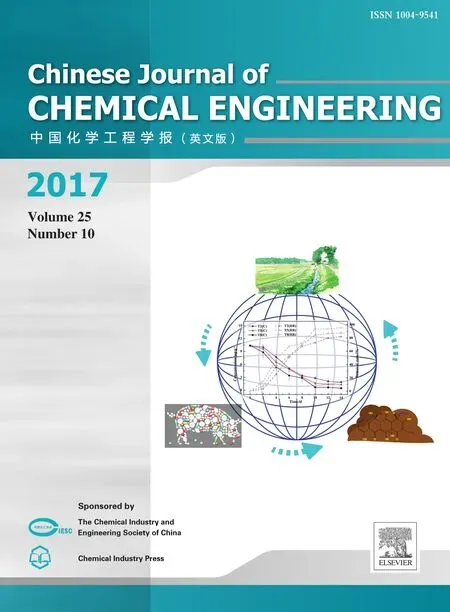 Chinese Journal of Chemical Engineering2017年10期
Chinese Journal of Chemical Engineering2017年10期
- Chinese Journal of Chemical Engineering的其它文章
- Effect of carboxymethyl cellulose on dissolution kinetics of carboxymethyl cellulose-sodium carbonate two-component tablet
- Crystallization of calcium silicate at elevated temperatures in highly alkaline system of Na2O-CaO-SiO2-H2O☆
- Aluminum impregnated silica catalyst for Friedel-Crafts reaction:Influence of ordering mesostructure☆
- Microencapsulation of stearic acid with polymethylmethacrylate using iron(III)chloride as photo-initiator for thermal energy storage☆
- Novel efficient procedure for biodiesel synthesis from waste oils with high acid value using 1-sulfobutyl-3-methylimidazolium hydrosulfate ionic liquid as the catalyst☆
- Toluene degradation by a water/silicone oil mixture for the design of two phase partitioning bioreactors
